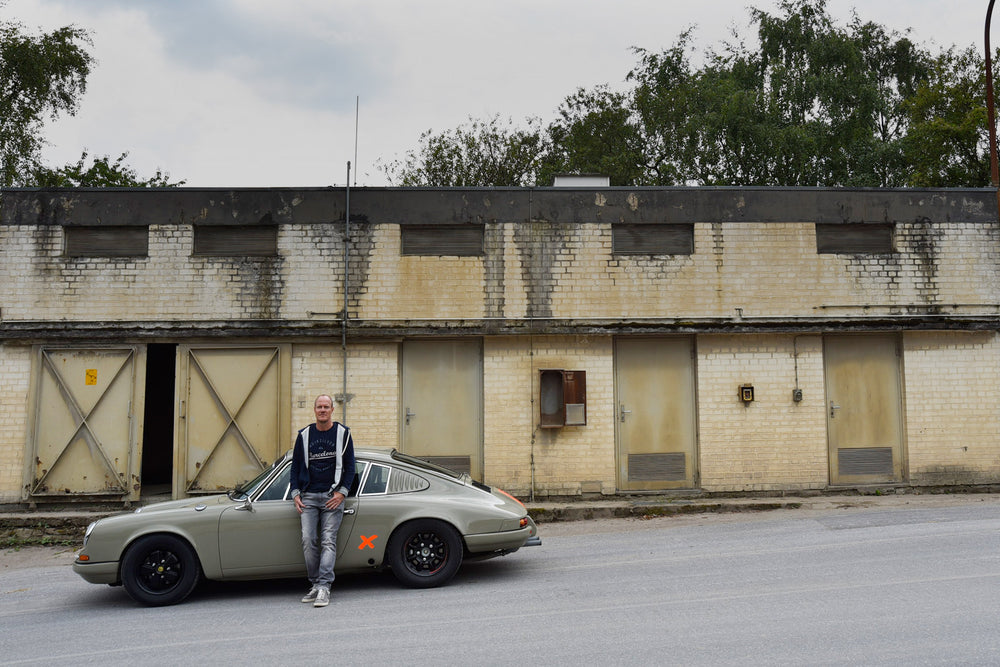The idea to customize an old 911 came up in 2013 when I went to my Porsche mechanic’s workshop to bring another car in for winter parking. It was then that I saw an old rusty 2.4-liter F-series and started thinking about how to rebuild it, to make it a bit sportier and cooler looking without being just another restoration of a vintage Porsche. I wanted it to be a car just for driving around in rather than something to leave parked, assuming that the attention it needed could be carried out with minimal effort, budget, and time.


The following months were spent gathering images for inspiration, and then came the sketching. As a car designer, achieving a distinctive look was very important to me. Color combinations, interior, seats, instrument; these were my points of customization, for if alterations to a 911 extend much further, it quickly becomes a mess. You cannot change a lot, but I knew that altering just a few elements in a cohesive way would be enough to make it stand out from the 911 crowd. The ideas grew slowly though, and after over a year of planning and dreaming I eventually realized that it was probably not a job to be done with a small budget after all, and that it would require a more or less complete restoration if I was to do this right. I also needed an expert partner for the project and a donor vehicle, which had its own criteria attached to the search: it couldn’t be too good (too expensive), but it also couldn’t be too bad (also too expensive, in its own way).



By chance, I discovered the website of Onassis Porsches Agency and asked the founder, Tom Gaedtke if he could help me with my vision. He seemed to be well connected in the custom Porsche scene, and having started his own outlaw shop I knew I would be working with someone who could appreciate what I was trying to do with this car. After a long phone call with him, we arranged a meeting at Classic Boxers in Erkrath, the factory of his friend Daniel Schaefer. Daniel had recently built himself a hot-rodded 912 at the time, and it provided a chance to sample the build quality (read: high) before we got to talking about my project.I had lugged along my big inspiration book as I call it, and after poring over the photos and sketches inside, we got to the salient details: it had to be an F-series with a narrow body; it had to be painted Stone Grey, and on the rear I wanted to place my bright contrasting graphic. I also wanted to fit the car with GFK mudguards and rear taillights resembling those of the infamous 911R.



Neither nor any combination of lightness and power were the focus for this build. What I was after was a look, a style that would evoke and celebrate the spirit of early racing Porsches while having a flair of street custom for good measure.
In the meeting I was very impressed by the perfectionism of the work of both Daniel and Tom, and I feeling the collective excitement for the project made me realize pretty quickly that I had found the right team to help build my 911. We got along very well from the first moment then, and we agreed to start the adventure.





Some days later, I stumbled upon a pretty good donor car near Frankfurt. It wasn’t running, but it was accident- and (almost) rust-free, and had a neat story of its life too; apparently the car was a US-model example, arriving in the States in 1970, which then returned home to Germany in the 1990s, where it was never put back on the road. The history was more or less completely unknown from this period. We kept finding new pieces of its past though—for instance, this $3 parking ticket from Santa Monica inside one of the air vent ducts. And as you can see, this served as the inspiration behind the big bold graphic offset to the right on the rear deck lid.



The project finally began in earnest in July of 2015, with the complete disassembly happening in the following weeks. All recoverable parts were revised or replaced by new ones, and as for the those upgrades, the existing four-speed transmission was replaced by a five-speed unit with a differential lock and a Wevo-shortshifter. The engine was completely rebuilt in the workshop of Matthias Hoeing in Hamburg, and was also expanded from 2.2 liters to 2.4 liters during that time. Equipped with carburetors and "Kremermodifikation" on the crankcase, it should all be work to produce almost 200HP.
So the mechanical bits were in good hands, and it was time to think about the styling.. The color is stone grey (paint code 7510), which is originally a 356 color, but was available as “special paint” for the 911 in 1966/67. The idea was to give the car a very unique look and some original details in the interior and exterior: the customized instruments with the modified rev-meter and clock dials for instance, and then the round fuel-cap in the fender and the rear side window with its new louvers for example.





Now that I am able to drive the car, it makes me smile to both experience a well-built early Porsche, but perhaps more rewarding is the realization of a few sketches and a chance run-in with a car that might have never received the love I've given it.
Markus Haub is a car designer and artist. He worked for Volkswagen and Renault in Barcelona. Since 2007 he is self-employed and exhibiting his artwork in various galleries in Spain, Germany, England or the USA. He lives and works in Spain and Germany.




















































